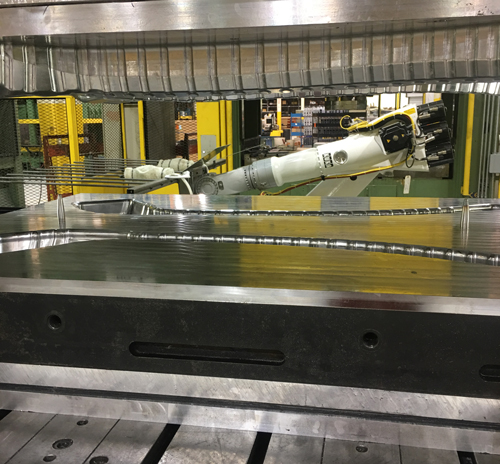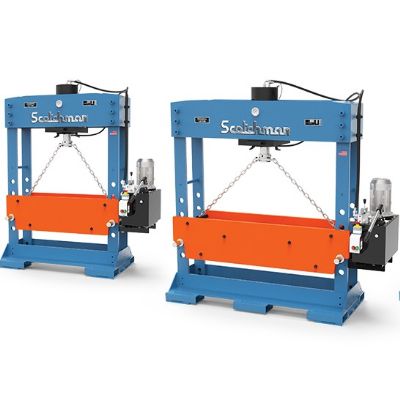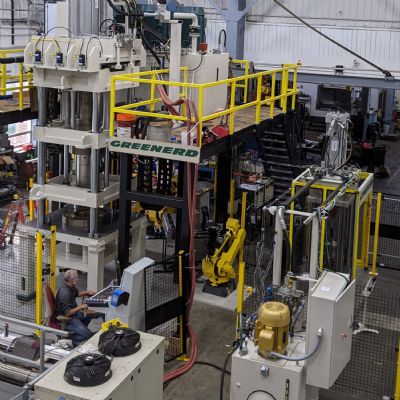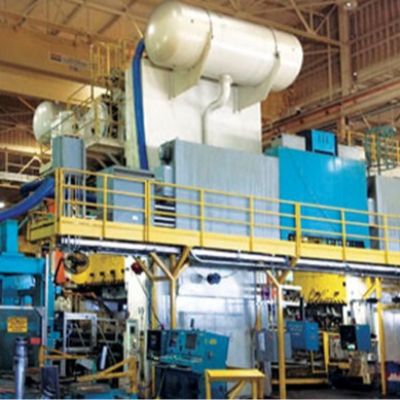Press Technology Optimized for Hot Stamping
Press builders, recognizing the hot stamping trend, leverage state-of-the-art technology to help optimize the process.
A hot stamping press requires a relatively long stroke and rapid closing of the die to minimize the time in air for the heated blank, a critical parameter for the hot stamping process.
This makes servohydraulic presses well-suited for such applications, report officials from AP&T North America, which supplied machines for Urgent Design & Manufacturing’s automated hot stamping cell and has developed a new generation of servohydraulic presses. Stampers reportedly can achieve significant energy savings during quenching and part handling when the slide stands still, as the servo motors in such servohydraulic presses operate at almost 0 rpm.
Also, hot stamping tooling normally contains high-force gas springs, which require a gas-spring-discharge function on the press to prevent hydraulic-system damage. This function allows the press to start the return stroke at a low speed, enabling the gas springs to push the slide up before the fast return stroke begins. Presses equipped with this function reportedly exhibit reduced cycle times as compared to conventional hydraulic presses.
Tooling Solutions Evolve to Keep Pace
To say that hot stamping taxes tooling is quite the understatement, and material providers as well as tool designers and builders are striving to meet the challenge.
“For hot stamping, we’ve seen an evolution of tool steel standard grades such as H13 and lower-alloyed steels, with all of that pushed upstream to higher-alloyed materials due to critical die expectations related to cycle time and wear,” says Tom Bell, executive director of Hitachi Metals.
Any material with yield strength surpassing 1200 MPa is considered for hot stamped parts, he notes, which truly stresses tooling. Tool-material providers are well aware of the challenges, and like press and tool builders, are working to meet the needs.
“The challenge in the tool steel business: meeting wear and toughness requirements simultaneously,” Bell says. “But meeting these properties makes the tool steel difficult to work with—more difficult to machine.”
Machining difficulty becomes extra challenging for hot stamping tooling, given the cooling channels and complex forms inherent in dies used in this process.
“The expanding requirements related to hot stamping keep us innovating,” Bell says.
He points to two technologies that have a role to play in tool material selection and die design/build for hot stamping: surface coatings and additive manufacturing (AM).
“As a steel maker, we want to make the best possible steel, meaning the best substrate and the best mechanical properties,” Bell says. “Surface coatings can help in terms of lubricity and wear, and we’re seeing development of coatings that can withstand hot stamping.”
As for AM, “3D printed inserts enable the creation of effective conformal cooling lines in hot stamping dies,” Bell says. “Traditionally, a water line in a hot stamping die runs along the X or Y axis—very linear. It doesn't always reach the surface of the die contour to cool as quickly as needed. AM inserts can be built to do that, which provides a big advantage.”
What remains to be seen, according to Bell, is whether AM technology can enable manufacture of inserts large enough to be effective in the very large hot stamping dies.AM-Specific Tool Steel Boasts Simplified Printing
As noted in this article, from production-line components to the manufacturing process itself, the metal forming industry continues to respond to the unique requirements of hot stamping and encourages the use of AM as a viable production option for mission-critical hot stamping tooling parts. As hot stamping is conducted on higher and higher strength steel materials, so, too, as Bell offers, must tool steel materials evolve to form such parts.
In his presentation at the Hot Stamping Experience and Tech Tour, Dr. Harald Lemke, chief commercial officer for Formetrix, details the R&D and application development work involved, and his stated payoff: Easy-to-print powdered tool steels formulated specifically for the laser powder bed fusion process. The result: Conformally cooled tool designs offering benefits such as shorter tool lead times, lower hot stamping cycle times and hot stamping of more complex parts.
Recounting his lengthy forming-material experience, Lemke cites the ever-present efforts to drive 3D printing down the cost curve.
“Back in 2007,” he recalls, “I realized that except for maraging steel, which isn’t very common in the tool steel industry, no tool steels could be printed easily via laser based powder bed fusion, the most common metal AM process.”
Those tool steels that were printed, he notes, required preheating of the material to 400 C or higher, thereby further increasing the 3D printing cost. Though no commercial metal printers existed at the time, Lemke was cognizant of what would be coming. As he explains, higher volumes of metal-powder production would drive down costs, and with AM reaching into higher-part-volume arenas such as automotive and industrial, an affordable AM steel powder with the needed hardness and toughness would be a boon to the industry as was the case decades ago with sintered powdered metal.
Combining such material with the AM process delivers an alternative to long tooling lead times while enabling design freedom. This is especially important in hot stamping, Lemke says, which often requires intricate cooling channels. Efficiently designed tooling also offers the opportunity to reduce cycle times—another hot stamping challenge.
In his presentation, Lemke discusses the properties, applications and benefits of a crack-free AM powder, printable at room temperature and exhibiting high hardness and high ductility. He also discusses the postprocessing options such as heat treatments, carburizing, nitriding and PVD coating under tight dimensional control and given surface-roughness requirements.
In researching and testing formulations in the quest for such AM powder, “I don't know how many hundreds of pieces I have seen cracking,” Lemke says. “The insidious thing is, sometimes we would print it, go home and celebrate success. Then after a day or two we would see the cracks. These developments took years of work and came to a successful conclusion.”
Further, the presentation will include parameters and printing speeds on different machines as well as heat treatment results from commercial heat treaters in the United States and Germany, as well as an economic outlook. One end-use success to be detailed by Lemke at the event relates to a hot stamped production part for a 2019 North American truck.
Resistance Welding a Fastening Option
A major aspect of hot stamping concerns joining, including the projection welding of fasteners, as these parts make their way into larger components and assemblies. Installing fasteners on hot stamped AlSi-coated parts can be tricky business owing to a number of factors, according to information from Weld Systems Integrators, which provides systems for capacitive discharge (CD) resistance welding in hot stamping applications.
Especially in these applications, fasteners are extremely soft as compared to the base material, causing the fastener projections to collapse before a good weld is achieved. In addition, hot stamped materials develop an AlSi coating in the furnace, with the resistive qualities of the coating inconsistent across the hot stamped part. On top of that, the short weld times called for in projection welding bring difficulty in delivering enough heat to the base material.
CD welding stores energy for rapid energy release with large peak currents, which means more energy into weld formation and less into heating the surrounding material, as well as a smaller heat-affected zone as compared to other welding processes. In metallurgy-critical hot stamping, these attributes prove advantageous, which is why, despite the above-listed challenges, projection welding of fasteners to hot stamped parts sees wide use.
Bob Kollins, senior application engineer with Technical Sales & Solutions, which works with end-users to set up and operate stand-alone Amada Miyachi-powered CD welding units from Weld Systems Integrators (WSI), along with Allen M. Agin, WSI Midwest regional sales manager, will describe fastener-welding challenges and solutions at the Hot Stamping Experience and Tech Tour.
“Since 2007, we’ve worked with Tier Ones and OEMs producing and processing hot stamped parts inhouse,” says Kollins. “Typically, materials arrive at a Tier supplier ready to be stamped. Hot stamping, on the other hand, involves inhouse processing, which varies from manufacturer to manufacturer. Variations exist across the industry and even across a part in terms of contact resistance, specifically at the interface where the fastener attaches to the part.”
CD welding technology, Kollins explains, can work with these variations by altering the weld current to match the current needed for resistance at that particular location on the part. Today, Kollins and Agin see a rise in hot stamping usage and applications, and continuously work on developing welding technology, such as a newly released machine and monitoring capability, to account for trends, including the use of thicker material. MF
View Glossary of Metalforming Terms
See also: AP&T North America Inc.
Technologies: Materials, Stamping Presses, Cutting








 MetalForming magazine’s one-of-a-kind event is designed dive deeply into the ever expanding world of hot stamping. The
MetalForming magazine’s one-of-a-kind event is designed dive deeply into the ever expanding world of hot stamping. The 

